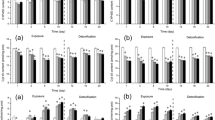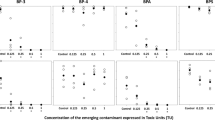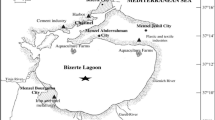Abstract
BP-3 is one of the most used organic UV filters. However, its widespread use and release into aquatic environment can induce ecotoxicological impact on aquatic organisms. Thus, the aim of the current study is to evaluate the gills and liver of freshwater fish Poecilia reticulata subjected to acute exposure (96 h) to BP-3 at environmentally relevant concentrations (10–1000 ng L−1). The study was based on adopting qualitative and semi-quantitative approach to assess histopathological changes and integrated the biomarker response in order to investigate organ-specific responses to BP-3 exposure. BP-3 has induced high histopathological index associated with circulatory disturbances, as well as with regressive and immunological changes in gills, whereas the hepatic histopathological index was associated with circulatory disturbances. Moreover, lower BP-3 concentrations were mostly associated with changes in gills, whereas higher BP-3 concentration was mostly linked to hepatic changes. In conclusion, acute exposure to BP-3 at environmentally relevant concentrations had stronger impact on gills than on the liver of P. reticulata, which confirmed organ-specific responses to UV filters.






Similar content being viewed by others
Data availability
The datasets used and/or analyzed during the current study are available from the corresponding author on reasonable request.
References
Agius C, Roberts RJ (2003) Melano-macrophage centres and their role in fish pathology. J Fish Dis 26:499–509. https://doi.org/10.1046/j.1365-2761.2003.00485.x
Alazemi BM, Lewis JW, Andrews EB (1996) Gill damage in the freshwater fish Gnathonemus petersii (Family: Mormyridae) exposed to selected pollutants: an ultrastructural study. Environ Technol 17:225–238. https://doi.org/10.1080/09593331708616381
Almeida SS et al (2019) Acute exposure to environmentally relevant concentrations of benzophenone-3 induced genotoxicity in Poecilia reticulata. Aquat Toxicol 216:105293. https://doi.org/10.1016/j.aquatox.2019.105293
Antunes AM et al (2017) Gender-specific histopathological response in guppies Poecilia reticulata exposed to glyphosate or its metabolite aminomethylphosphonic acid. J Appl Toxicol 37:1098–1107. https://doi.org/10.1002/jat.3461
Arya S, Dwivedi AK, Alvarado L, Kupesic-Plavsic S (2020) Exposure of U.S. population to endocrine disruptive chemicals (parabens, Benzophenone-3, Bisphenol-A and triclosan) and their associations with female infertility. Environ Pollut 114763. https://doi.org/10.1016/j.envpol.2020.114763
Balmer ME, Buser H-R, Müller MD, Poiger T (2005) Occurrence of some organic UV filters in wastewater, in surface waters, and in fish from Swiss Lakes. Environ Sci Technol 39:953–962. https://doi.org/10.1021/es040055r
Beedanagari S, Vulimiri SV, Bhatia S, Mahadevan B (2014) Chapter 43 - Genotoxicity biomarkers: molecular basis of genetic variability and susceptibility. In: Gupta RC (ed) Biomarkers in toxicology. Academic Press, Boston, pp 729–742. https://doi.org/10.1016/B978-0-12-404630-6.00043-9
Bernet D, Schmidt H, Meier W, Burkhardt-Holm P, Wahli T (1999) Histopathology in fish: proposal for a protocol to assess aquatic pollution. J Fish Dis 22:25–34. https://doi.org/10.1046/j.1365-2761.1999.00134.x
Blüthgen N, Zucchi S, Fent K (2012) Effects of the UV filter benzophenone-3 (oxybenzone) at low concentrations in zebrafish (Danio rerio). Toxicol Appl Pharmacol 263:184–194. https://doi.org/10.1016/j.taap.2012.06.008
Camargo MMP, Martinez CBR (2007) Histopathology of gills, kidney and liver of a Neotropical fish caged in an urban stream. Neotrop Ichthyol 5:327–336
Chaves MJS, Barbosa SC, Malinowski MM, Volpato D, Castro IB, Franco TCRS, Primel EG (2020) Pharmaceuticals and personal care products in a Brazilian wetland of international importance: Occurrence and environmental risk assessment. Sci Total Environ 734:139374. https://doi.org/10.1016/j.scitotenv.2020.139374
Coldwell W (2018) Hawaii becomes first US state to ban sunscreens harmful to coral reefs.
Coronado M, De Haro H, Deng X, Rempel MA, Lavado R, Schlenk D (2008) Estrogenic activity and reproductive effects of the UV-filter oxybenzone (2-hydroxy-4-methoxyphenyl-methanone) in fish. Aquat Toxicol 90:182–187. https://doi.org/10.1016/j.aquatox.2008.08.018
Costa PM et al (2009) Histological biomarkers in liver and gills of juvenile Solea senegalensis exposed to contaminated estuarine sediments: A weighted indices approach. Aquat Toxicol 92:202–212. https://doi.org/10.1016/j.aquatox.2008.12.009
Díaz-Cruz MS, Molins-Delgado D, Serra-Roig MP, Kalogianni E, Skoulikidis NT, Barceló D (2019) Personal care products reconnaissance in EVROTAS river (Greece): Water-sediment partition and bioaccumulation in fish. Sci Total Environ 651:3079–3089. https://doi.org/10.1016/j.scitotenv.2018.10.008
Downs CA, Kramarsky-Winter E, Segal R, Fauth J, Knutson S, Bronstein O, Ciner FR, Jeger R, Lichtenfeld Y, Woodley CM, Pennington P, Cadenas K, Kushmaro A, Loya Y (2016) Toxicopathological effects of the sunscreen UV filter, oxybenzone (benzophenone-3), on coral planulae and cultured primary cells and its environmental contamination in Hawaii and the U.S. Virgin Islands. Arch Environ Contam Toxicol 70:265–288. https://doi.org/10.1007/s00244-015-0227-7
Emnet P, Gaw S, Northcott G, Storey B, Graham L (2015) Personal care products and steroid hormones in the Antarctic coastal environment associated with two Antarctic research stations, McMurdo Station and Scott Base. Environ Res 136:331–342. https://doi.org/10.1016/j.envres.2014.10.019
Evans DH, Piermarini PM, Choe KP (2005) The multifunctional fish gill: dominant site of gas exchange, osmoregulation, acid-base regulation, and excretion of nitrogenous waste. Physiol Rev 85:97–177. https://doi.org/10.1152/physrev.00050.2003
Flores-Lopes F, Thomaz AT (2011) Histopathologic alterations observed in fish gills as a tool in environmental monitoring. Braz J Biol 71:179–188
Giokas DL, Salvador A, Chisvert A (2007) UV filters: from sunscreens to human body and the environment. TrAC Trends Anal Chem 26:360–374. https://doi.org/10.1016/j.trac.2007.02.012
Grabicova K et al (2013) Presence of UV filters in surface water and the effects of phenylbenzimidazole sulfonic acid on rainbow trout (Oncorhynchus mykiss) following a chronic toxicity test. Ecotoxicol Environ Saf 96:41–47. https://doi.org/10.1016/j.ecoenv.2013.06.022
Hued AC, Oberhofer S, Bistoni MA (2012) Exposure to a commercial glyphosate formulation (Roundup®) alters normal gill and liver histology and affects male sexual activity of Jenynsia multidentata (Anablepidae, Cyprinodontiformes). Arch Environ Contam Toxicol 62:107–117. https://doi.org/10.1007/s00244-011-9686-7
Iribarne-Durán LM et al (2020) Menstrual blood concentrations of parabens and benzophenones and related factors in a sample of Spanish women: An exploratory study. Environ Res 183:109228. https://doi.org/10.1016/j.envres.2020.109228
ISO (1996) Water quality -- Determination of the acute lethal toxicity of substances to a freshwater fish [Brachydanio rerio Hamilton-Buchanan (Teleostei, Cyprinidae)], 2nd edn. ISO - International Organization for Standardization
Karlsson L (1983) Gill morphology in the zebrafish, Brachydanio rerio (Hamilton- Buchanan). J Fish Biol 23:511–524. https://doi.org/10.1111/j.1095-8649.1983.tb02931.x
Kim S, Choi K (2014) Occurrences, toxicities, and ecological risks of benzophenone-3, a common component of organic sunscreen products: a mini-review. Environ Int 70:143–157. https://doi.org/10.1016/j.envint.2014.05.015
Liebel S, Tomotake MEM, Ribeiro CAO (2013) Fish histopathology as biomarker to evaluate water quality. Ecotoxicol Environ Contam 8:9–15. https://doi.org/10.5132/eec.2013.02.002
Liu H, Sun P, Liu H, Yang S, Wang L, Wang Z (2015) Hepatic oxidative stress biomarker responses in freshwater fish Carassius auratus exposed to four benzophenone UV filters. Ecotoxicol Environ Saf 119:116–122. https://doi.org/10.1016/j.ecoenv.2015.05.017
Mao F, He Y, Gin KY-W (2019) Occurrence and fate of benzophenone-type UV filters in aquatic environments: a review. Environ Sci Water Res Technol 5:209–223. https://doi.org/10.1039/C8EW00539G
Meng Q, Yeung K, Kwok ML, Chung CT, Hu XL, Chan KM (2020) Toxic effects and transcriptome analyses of zebrafish (Danio rerio) larvae exposed to benzophenones. Environ Pollut 265:114857. https://doi.org/10.1016/j.envpol.2020.114857
Moeder M, Schrader S, Winkler U, Rodil R (2010) At-line microextraction by packed sorbent-gas chromatography–mass spectrometry for the determination of UV filter and polycyclic musk compounds in water samples. J Chromatogr A 1217:2925–2932. https://doi.org/10.1016/j.chroma.2010.02.057
Molins-Delgado D et al (2018) Occurrence of organic UV filters and metabolites in lebranche mullet (Mugil liza) from Brazil. Sci Total Environ 618:451–459. https://doi.org/10.1016/j.scitotenv.2017.11.033
OECD (1992) Test No. 203: Fish, Acute Toxicity Test. OECD Publishing, Paris
Perry SF, Laurent P (1993) Environmental effects on fish gill structure and function. In: Rankin JC, Jensen FB (eds) Fish Ecophysiology. Springer Netherlands, Dordrecht, pp 231–264. https://doi.org/10.1007/978-94-011-2304-4_9
Qualhato G, Saboia-Morais SMT, Silva LD, Rocha TL (2018) Melanomacrophage response and hepatic histopathologic biomarkers in the guppy Poecilia reticulata exposed to iron oxide (maghemite) nanoparticles. Aquat Toxicol 198:63–72. https://doi.org/10.1016/j.aquatox.2018.02.014
Rajkumar KS, Kanipandian N, Thirumurugan R (2016) Toxicity assessment on haemotology, biochemical and histopathological alterations of silver nanoparticles-exposed freshwater fish Labeo rohita. Appl Nanosci 6:19–29. https://doi.org/10.1007/s13204-015-0417-7
Rašković B, Jarić I, Koko V, Spasić M, Dulić Z, Marković Z, Poleksić V (2013) Histopathological indicators: a useful fish health monitoring tool in common carp (Cyprinus carpio Linnaeus, 1758) culture. Cent Eur J Biol 8:975–985. https://doi.org/10.2478/s11535-013-0220-y
Rocha TL, Santos APR, Yamada AT, Soares CMA, Borges CL, Bailão AM, Sabóia-Morais SMT (2015) Proteomic and histopathological response in the gills of Poecilia reticulata exposed to glyphosate-based herbicide. Environ Toxicol Pharmacol 40:175–186. https://doi.org/10.1016/j.etap.2015.04.016
Rodrigues S, Antunes SC, Nunes B, Correia AT (2019) Histopathological effects in gills and liver of Sparus aurata following acute and chronic exposures to erythromycin and oxytetracycline. Environ Sci Pollut Res 26:15481–15495. https://doi.org/10.1007/s11356-019-04954-0
Santos AP, Rocha TL, Borges CL, Bailão AM, Soares CMA, Sabóia-Morais SMT (2017) A glyphosate-based herbicide induces histomorphological and protein expression changes in the liver of the female guppy Poecilia reticulata. Chemosphere 168:933–943. https://doi.org/10.1016/j.chemosphere.2016.10.116
Santos DMS, Melo MRS, Mendes DCS, Rocha IKBS, Silva JPL, Cantanhêde SM, Meletti PC (2014) Histological changes in gills of two fish species as indicators of water quality in Jansen Lagoon (São Luís, Maranhão State, Brazil). Int J Environ Res Public Health 11. https://doi.org/10.3390/ijerph111212927
Shin JC, Lee E, An S, Jin SH, Ha J, Choi WJ, Noh M (2020) Benzophenone-3 and benzophenone-8 exhibit obesogenic activity via peroxisome proliferator-activated receptor γ pathway. Toxicol in Vitro 67:104886. https://doi.org/10.1016/j.tiv.2020.104886
Silva CP, Emídio ES, Marchi MR (2015) The occurrence of UV filters in natural and drinking water in São Paulo State (Brazil). Environ Sci Pollut Res Int 22:19706–19715. https://doi.org/10.1007/s11356-015-5174-3
StatSoft (2004) “Statistica,” data analysis software system, version 7, version 7 edn
Steinel NC, Bolnick DI (2017) Melanomacrophage centers as a histological indicator of immune function in fish and other poikilotherms. Front Immunol 8:827
Strzyżewska-Worotyńska E, Szarek J, Babińska I, Gulda D (2017) Gills as morphological biomarkers in extensive and intensive rainbow trout (Oncorhynchus mykiss, Walbaum 1792) production technologies. Environ Monit Assess 189:611. https://doi.org/10.1007/s10661-017-6278-7
Tao J et al (2020) Environmental relevant concentrations of benzophenone-3 induced developmental neurotoxicity in zebrafish. Sci Total Environ 721:137686. https://doi.org/10.1016/j.scitotenv.2020.137686
Torrealba D, More-Bayona JA, Wakaruk J, Barreda DR (2019) Innate immunity provides biomarkers of health for teleosts exposed to nanoparticles. Front Immunol 9:3074
Tsui MMP et al (2014) Occurrence, distribution and ecological risk assessment of multiple classes of UV filters in surface waters from different countries. Water Res 67:55–65. https://doi.org/10.1016/j.watres.2014.09.013
van der Oost R, Beyer J, Vermeulen NPE (2003) Fish bioaccumulation and biomarkers in environmental risk assessment: a review. Environ Toxicol Pharmacol 13:57–149. https://doi.org/10.1016/S1382-6689(02)00126-6
Wolf JC, Wheeler JR (2018) A critical review of histopathological findings associated with endocrine and non-endocrine hepatic toxicity in fish models. Aquat Toxicol 197:60–78. https://doi.org/10.1016/j.aquatox.2018.01.013
Xue J, Liu W, Kannan K (2017) Bisphenols, benzophenones, and bisphenol A diglycidyl ethers in textiles and infant clothing. Environ Sci Technol 51:5279–5286. https://doi.org/10.1021/acs.est.7b00701
Yancheva V, Velcheva I, Stoyanova S, Georgieva E (2015) Fish in ecotoxicological studies. Ecol Balkanica 7:149–169
Zhao H, Wei D, Li M, Du Y (2013) Substituent contribution to the genotoxicity of benzophenone-type UV filters. Ecotoxicol Environ Saf 95:241–246. https://doi.org/10.1016/j.ecoenv.2013.05.036
Funding
This work was supported by State University of Goiás (UEG; No. 201600020010791) in Brazil, Fundação de Amparo à Pesquisa do Estado de Goiás (FAPEG; PPP/201610267001019) in Brazil, and Conselho Nacional de Desenvolvimento Científico e Tecnológico (CNPq; 421759/2018-6) in Brazil. The author SSA was granted with a scholarship from FAPEG, whereas authors VSO and MRD were granted with scholarships from UEG. EFLCB was supported by UEG with a fellowship at the PROBIP program (Scientific Production Support Program).
Author information
Authors and Affiliations
Contributions
Material preparation, data collection, and analysis were performed by SSA, VSO, MRD, LLB, TLR, and EFLCB. TLR, SMTSM, and EFLCB contributed to the study conception and design. TLR and EFLCB wrote the first draft of the manuscript and all authors contributed to and approved the final version of the manuscript.
Corresponding author
Ethics declarations
Ethics approval and consent to participate
The Animal Research Ethics Committees from State University of Goiás (UEG; protocol n° 009/2016) and from Federal University of Goiás (UFG; protocol n° 046/2017) have approved the experimental and animal management procedures. The experiment has followed the OECD 203 guidelines for acute toxicity test of chemicals on fish (OECD 1992).
Consent for publication
Not applicable
Competing interests
The authors declare no competing interests.
Additional information
Responsible Editor: Bruno Nunes
Publisher’s note
Springer Nature remains neutral with regard to jurisdictional claims in published maps and institutional affiliations.
Rights and permissions
About this article
Cite this article
dos Santos Almeida, S., Silva Oliveira, V., Ribeiro Dantas, M. et al. Environmentally relevant concentrations of benzophenone-3 induce differential histopathological responses in gills and liver of freshwater fish. Environ Sci Pollut Res 28, 44890–44901 (2021). https://doi.org/10.1007/s11356-021-13839-0
Received:
Accepted:
Published:
Issue Date:
DOI: https://doi.org/10.1007/s11356-021-13839-0




